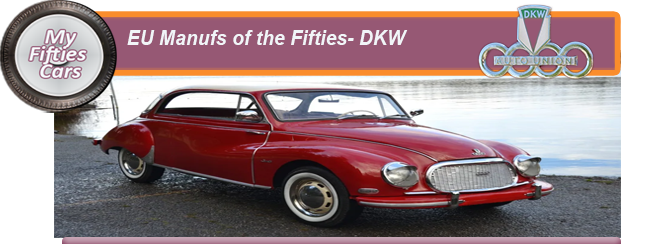 DKW was a German manufacturer of automobiles, motorcycles, and pedal cycles, founded in 1916. The company's name originally stood for "Dampf-Kraft-Wagen" (steam-powered vehicle), but it was changed to "Das Kleine Wunder" (the little wonder) in 1923. DKW is best known for its small, two-stroke engine vehicles, which were popular in the interwar period and immediately after World War II. The company was a key player in the development of the modern, front-wheel drive, two-stroke engine.
DKW was a German manufacturer of automobiles, motorcycles, and pedal cycles, founded in 1916. The company's name originally stood for "Dampf-Kraft-Wagen" (steam-powered vehicle), but it was changed to "Das Kleine Wunder" (the little wonder) in 1923. DKW is best known for its small, two-stroke engine vehicles, which were popular in the interwar period and immediately after World War II. The company was a key player in the development of the modern, front-wheel drive, two-stroke engine.
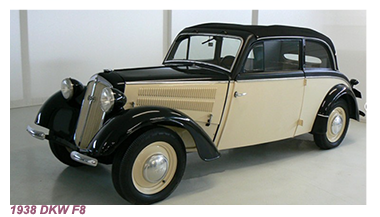
Like so many European car manufacturers, Germany’s DKW had a long history. It began during World War I, when J.S. Rasmussen, a manufacturer of boiler fittings, turned to the production of steam-powered vehicles under the Dampf-Kraft-Wagen label. (DKW)
A few years later, DKW Rasmussen began the production of was involved with electric automobiles, powered bicycles, and DKW motorcycles, which came to be known as "Das Kleine Wunder" (the little wonder).
By the late twenties, DKW had expanded to such an extent that they were regrded as the world's largest manufacturer of motorcycles.
A y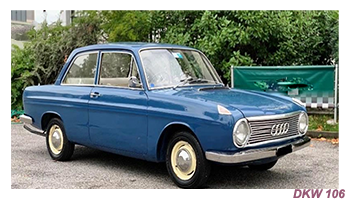 ear later came the first gasoline-powered cars, using a two-stroke engine. In 1932, Auto Union GbmH was formed in what would later become East Germany, with the company formed as a result of a rapidly formed amalgamation of DKW, Horch, and Wanderer.
ear later came the first gasoline-powered cars, using a two-stroke engine. In 1932, Auto Union GbmH was formed in what would later become East Germany, with the company formed as a result of a rapidly formed amalgamation of DKW, Horch, and Wanderer.
Although some rear-wheel-drive models were built, the organization became best known for its front-drive autos and famed racing vehicles.
 After the war, two entirely different successors to the pre-war DKW emerged by 1949: one in East Germany, the other produced by a revived Auto Union company based in Ingolstadt, West Germany.
After the war, two entirely different successors to the pre-war DKW emerged by 1949: one in East Germany, the other produced by a revived Auto Union company based in Ingolstadt, West Germany.
At "DKW is Here Again," the banner at the 1949 Technical Exposition in Hamburg, only a motorcycle and a commercial van were on show.
![]()
A single-cylinder engine powering a choice of light commercial vehicles were the first post-war models on offer from Auto Union, followed by a three-cylinder saloon based on the version that had been created before the war, followed by a closed coupe and cabriolet.
By 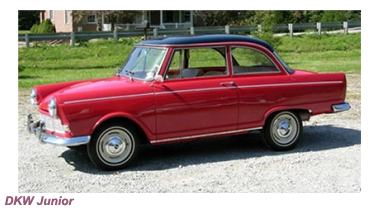 1952, about 25,000 of the two-cylinder DKWs were produced yearly, with predictions of 2,000 per month in 1954 (nearly one for export).
1952, about 25,000 of the two-cylinder DKWs were produced yearly, with predictions of 2,000 per month in 1954 (nearly one for export).
In 1954, DKW won the European championship for production, finishing far ahead of its competitors.
DKW models began to reach the U.S. in significant numbers, with their former horizontal-bar grille switched to the more familiar oval grille with a mesh pattern and the distinctively curved DKW body silhouette (somewhat like a Morris Minor) that lasted until 1961.
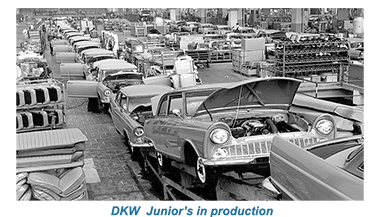 This is the content for Layout P Tag
This is the content for Layout P Tag
The rear-engine Three-Six was slightly more curved than in prior models, for improved streamlining and also to allow greater luggage space.
The water-cooled three-cylinder, two-cycle engine stood well ahead of For lubrication, gasoline and oil had to be mixed in the fuel tank.
 A four-gearbox system worked through a single dry-plate clutch, driving the front wheels.Orginally avialabe as a two-door only, although a four-door version was added in 1956. The four door rode a longer wheelbase and could be had in a station wagon format.
A four-gearbox system worked through a single dry-plate clutch, driving the front wheels.Orginally avialabe as a two-door only, although a four-door version was added in 1956. The four door rode a longer wheelbase and could be had in a station wagon format.
The four-door version came fitted with vent windows at the rear and bench-type seating in the front.
One of the later variatons was a true hardtop coupe, with no "B" pillar. The TI Coupe Deluxe did have side pillars and was available with an optional slide roof.
![]()
Despite its small footprint (at least by American standards), the DKW could fit five passengers (up to six for the four-door).
The front passenger seat tilted forward, while the backrest of the driver's seat was modified in 1956, sideways and to the front.
Sed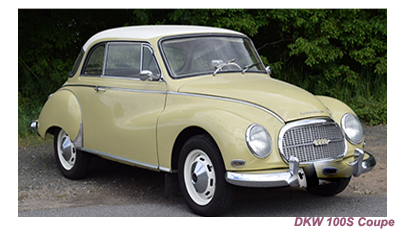 ans and station wagons remained popular during the Fifties, but the two-seat and four-seat convertibles were less common, coming in just two colours to match the available two-tone body paint.
ans and station wagons remained popular during the Fifties, but the two-seat and four-seat convertibles were less common, coming in just two colours to match the available two-tone body paint.
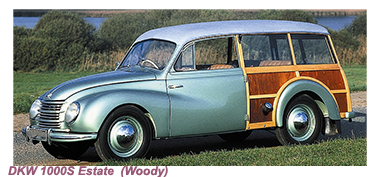 Early DKWs had semaphore-style directional signals, while a Saxomat magnetic clutch operated with a flywheel, eliminating the clutch pedal was optional.
Early DKWs had semaphore-style directional signals, while a Saxomat magnetic clutch operated with a flywheel, eliminating the clutch pedal was optional.
The Sonderklasse grosser 3-6, in production between 1953 and 1959, came as a two-door saloon, a four-door saloon, a station wagon, a four-seater coupe, as well as two and four-seater cabriolets.
The1000 was readily identifiable thanks to its wraparound screen and cross-hatched oval grille, which combined to provide a much more symmetrical appearance.
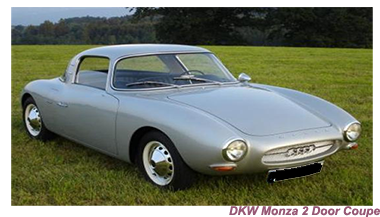
 Capable of generating around 44bhp, with the S version capable of generating as much as 50bhp and a speed of 80mph. the 1000 packed a lot of power for a Fifties saloon.
Capable of generating around 44bhp, with the S version capable of generating as much as 50bhp and a speed of 80mph. the 1000 packed a lot of power for a Fifties saloon.
Eventually DKW came under Daimler-Benz control in 1958, who wasted little time in doing away with all the familiar two-stroke- engined modelss. DKW became part of the Volkswagen Group in 1965.

